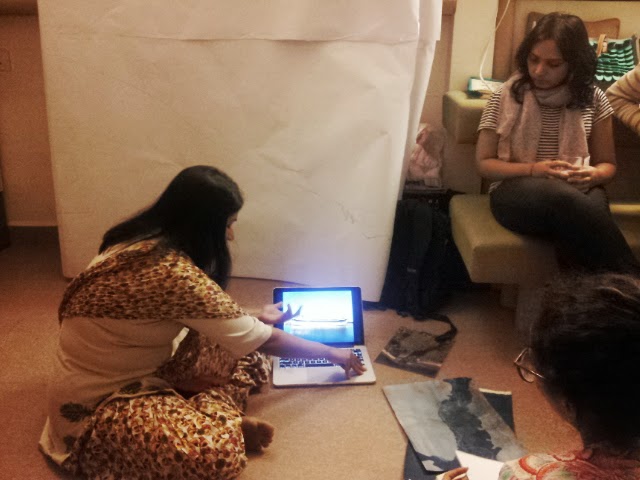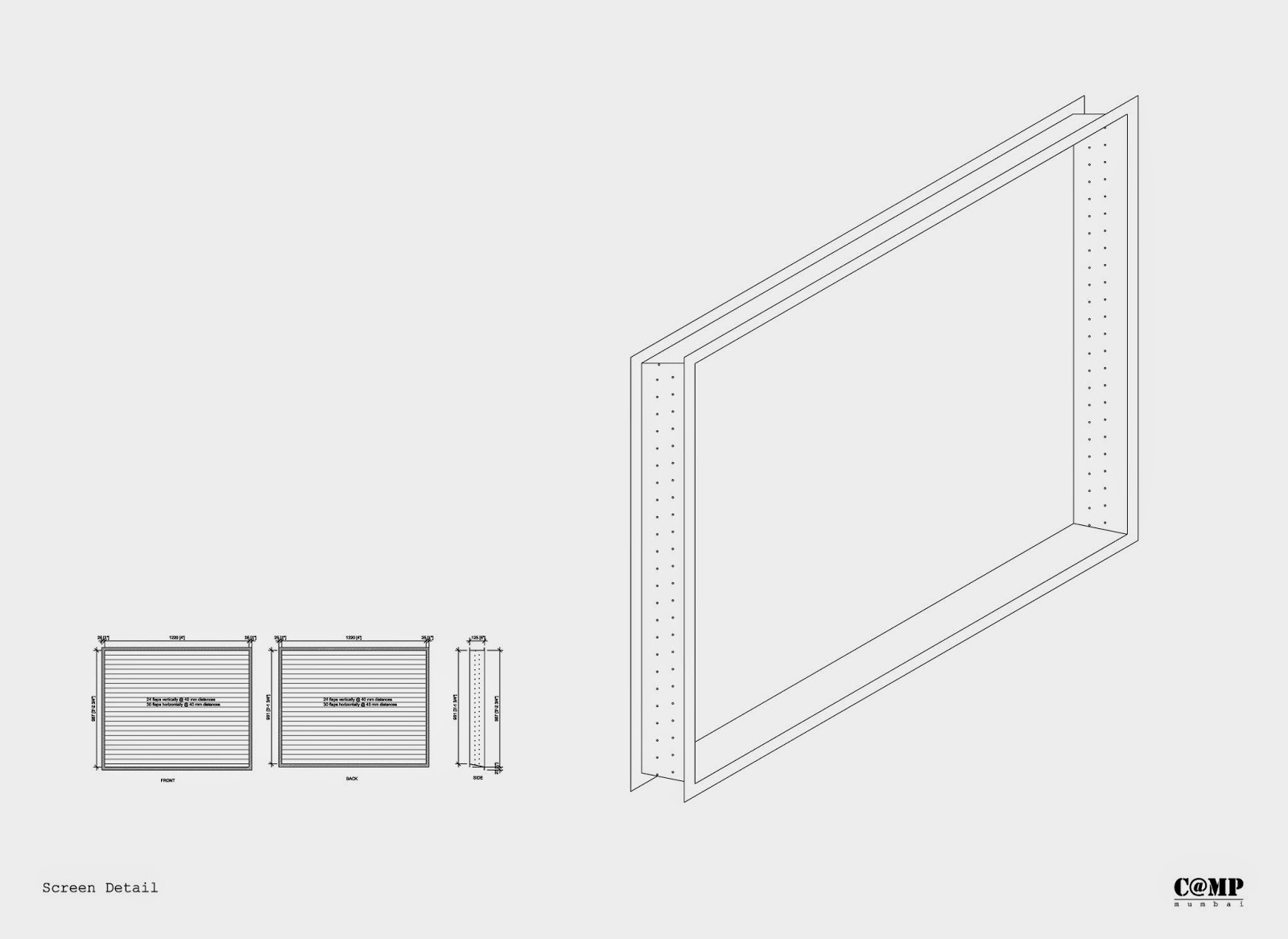The last exhibition that I was involved with CAMP took place at the Chemould Art Gallery in Mumbai, and was titled 'Night for Day'. The exhibition hosted a collection of several video works done by CAMP over the years since their inception. The gallery was imagined to be converted into the environment of the night - in reference to several things. Quite straightforwardly, one needs a dark environment to project film. Further, the artists' introduction refers to the technique of 'Day for night' which involved putting a dark filter over the camera lens to shoot night scenes during the day in the olden times. The larger overarching of the exhibition idea alludes to the "Nights of Labour" in which philosopher Jacques Ranciere begins to imagine the life of labour in the night, when after work, they enter a new world of pleasure, imagination and rest.
'Night for Day' brings these ideas in common discussion with each other. Ashok and Shaina were quite clear that the gallery space would be populated with screens for this show. However, merely putting same sized screens showing different projects was not enough. The projections had to create an environment, a journey of their own for the viewer. Thus, several iterations of different screen sizes and their arrangements were made.
I quickly put together a model of the interior gallery space so that we could visualize the different screens on different walls. For the project "Interior Design" (which was also shown at Jorbagh in Delhi) one of the existing windows of Chemould was opened up. A cornered altar space was carved for this project by creating an artificial wall, which reconfigured the gallery. After substantial juggling, the screen sizes were finalized. The projectors for the show (8 in all) were sourced from across different galleries in the city, including the ones in Chemould itself. Perhaps this was the most ambitious aspect of the exhibition.
Since the interior environment was to be dark, Shaina proposed to have the wall text in radium. I made some basic research to find people who could actually help create this in radium instead of conventional vinyl. It was a fun task to understand how vinyl texts are actually made. I finally met a guy in the industrial area of Goregaon who had been doing this job for decades. Originally he would do radium sticker cut outs manually. Today, he has a machine installed at his home in which he is able to do execute smaller jobs.
On site, we had to figure out ways of suspending the projectors in accurate angles and positions to get accurate projections. The screens had to appear "floating". They were in two ratios - 4:3 and 16:9. Some were painted on the wall while others were fabricated and mounted with the screen fabric. Making a frame for large screens is tricky. We had learnt from our experience in Kolkata, Delhi and Bhau Daji Lad in Mumbai that either wood or steel structures bend / cave in when the canvas is tightened onto them. The structure and material of the screens were thus improvised. The new challenges were to project on an angular surface.
The projectors were hung at angles in quite ad-hoc, but workable ways. They were suspended on steel cross beams put onto the existing I sections in the gallery at different lengths. Such an assembly helped manipulate coordinates w.r.t. the constantly shifting screen positions. Once the projector positions were finalized, they all were connected with wires in a way that they were concealed. The last step was to connect speakers wherever applicable.
The works of Interior Design and Marine Drive were to be made technically sound, and were handled by Ashok. A lot of background work remains invisible behind their smooth functioning. I remained, to a large extent, a passive observer in the way the artists took final decisions. All of this was too new for me to contribute. In addition, I was not confident if I understood and aligned with the aesthetic of the final show that Ashok and Shaina were anticipating. A lot of times, artists are working towards something that they cannot express or communicate. It is only in the making that the aesthetic and other decisions become clear.
A lot of fine tuning goes into the final reception of video art. In this case, for example, the simultaneous working of the different screens all round in a single gallery space creates a unique experience. The artist does not necessarily have the luxury to experience it while editing single videos in his / her own studio. What meanings do two images appearing together make? How does one choreograph them? The simultaneity of images creates new art, new poetry - something that Shaina would always keep drawing attention passingly during the edits. The way in which the different films being projected in one time brings unity to a story, a project. This was perhaps crucial for the perception of 'Night for Day'.
The opening of the show was attended by Steven Holl himself, who had come down to the city, for his office has been selected over an architectural competition to build the extension of the Bhau Daji Lad Museum. Steven Holl thus also saw CAMP's intervention at Bhau Daji Lad. There were several ideas the Shaina and Ashok opened up with the simultaneous images reeling in the gallery space. They would perhaps be best to discuss the overall show.
For me, Steven Holl's presentation 'Urban Hopes' at Bhau Daji Lad was quite an occasion - almost a co-incidental spatio-temporal curation in my career. Steven Holl had collaborated with Opolis, where I worked as an architect for a year after graduation. CAMP was an artist group with whom I collaborated with after my post graduation. Bhau Daji Lad was the museum where the intervention of CAMP was running when the architect came. Incidentally, Ashok and Rahul Gore (principal, Opolis) have both studied at UCLA, USA. Holl's lecture at BDL collided all these people, spaces and times together! I think that was a good finale to my engagement with CAMP. Not only is such coincidence serendipitous, but it offers a certain resonance in choices that I seem to have (consciously) made thus far.

'Night for Day' brings these ideas in common discussion with each other. Ashok and Shaina were quite clear that the gallery space would be populated with screens for this show. However, merely putting same sized screens showing different projects was not enough. The projections had to create an environment, a journey of their own for the viewer. Thus, several iterations of different screen sizes and their arrangements were made.
I quickly put together a model of the interior gallery space so that we could visualize the different screens on different walls. For the project "Interior Design" (which was also shown at Jorbagh in Delhi) one of the existing windows of Chemould was opened up. A cornered altar space was carved for this project by creating an artificial wall, which reconfigured the gallery. After substantial juggling, the screen sizes were finalized. The projectors for the show (8 in all) were sourced from across different galleries in the city, including the ones in Chemould itself. Perhaps this was the most ambitious aspect of the exhibition.
Since the interior environment was to be dark, Shaina proposed to have the wall text in radium. I made some basic research to find people who could actually help create this in radium instead of conventional vinyl. It was a fun task to understand how vinyl texts are actually made. I finally met a guy in the industrial area of Goregaon who had been doing this job for decades. Originally he would do radium sticker cut outs manually. Today, he has a machine installed at his home in which he is able to do execute smaller jobs.
On site, we had to figure out ways of suspending the projectors in accurate angles and positions to get accurate projections. The screens had to appear "floating". They were in two ratios - 4:3 and 16:9. Some were painted on the wall while others were fabricated and mounted with the screen fabric. Making a frame for large screens is tricky. We had learnt from our experience in Kolkata, Delhi and Bhau Daji Lad in Mumbai that either wood or steel structures bend / cave in when the canvas is tightened onto them. The structure and material of the screens were thus improvised. The new challenges were to project on an angular surface.
The projectors were hung at angles in quite ad-hoc, but workable ways. They were suspended on steel cross beams put onto the existing I sections in the gallery at different lengths. Such an assembly helped manipulate coordinates w.r.t. the constantly shifting screen positions. Once the projector positions were finalized, they all were connected with wires in a way that they were concealed. The last step was to connect speakers wherever applicable.
The works of Interior Design and Marine Drive were to be made technically sound, and were handled by Ashok. A lot of background work remains invisible behind their smooth functioning. I remained, to a large extent, a passive observer in the way the artists took final decisions. All of this was too new for me to contribute. In addition, I was not confident if I understood and aligned with the aesthetic of the final show that Ashok and Shaina were anticipating. A lot of times, artists are working towards something that they cannot express or communicate. It is only in the making that the aesthetic and other decisions become clear.
A lot of fine tuning goes into the final reception of video art. In this case, for example, the simultaneous working of the different screens all round in a single gallery space creates a unique experience. The artist does not necessarily have the luxury to experience it while editing single videos in his / her own studio. What meanings do two images appearing together make? How does one choreograph them? The simultaneity of images creates new art, new poetry - something that Shaina would always keep drawing attention passingly during the edits. The way in which the different films being projected in one time brings unity to a story, a project. This was perhaps crucial for the perception of 'Night for Day'.
The opening of the show was attended by Steven Holl himself, who had come down to the city, for his office has been selected over an architectural competition to build the extension of the Bhau Daji Lad Museum. Steven Holl thus also saw CAMP's intervention at Bhau Daji Lad. There were several ideas the Shaina and Ashok opened up with the simultaneous images reeling in the gallery space. They would perhaps be best to discuss the overall show.
For me, Steven Holl's presentation 'Urban Hopes' at Bhau Daji Lad was quite an occasion - almost a co-incidental spatio-temporal curation in my career. Steven Holl had collaborated with Opolis, where I worked as an architect for a year after graduation. CAMP was an artist group with whom I collaborated with after my post graduation. Bhau Daji Lad was the museum where the intervention of CAMP was running when the architect came. Incidentally, Ashok and Rahul Gore (principal, Opolis) have both studied at UCLA, USA. Holl's lecture at BDL collided all these people, spaces and times together! I think that was a good finale to my engagement with CAMP. Not only is such coincidence serendipitous, but it offers a certain resonance in choices that I seem to have (consciously) made thus far.













































